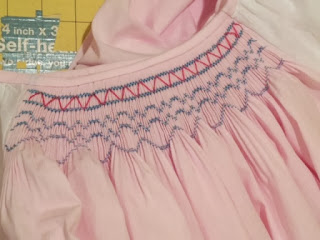If you missed the last two series, you can find the 1st
here and the 2nd
here. In part one, we cut and stitched the ties together, and in part two, we backed the plate.
In part 3, we will cut the circle, hem it and attach it to the dresen. I purposely put this part by itself, because I came up with an absolute sure fire way to get THE perfect circle with the hem. I searched and searched the web on how to do this and could find nothing. So if someone else has already done this, let me know so I can give credit where credit is due. For now, I'd like to think I am the circle queen! hahahaha In all honesty, this idea is the same concept as Jeannie B. uses on
Old Fashioned Baby to stitch the hem on baby daygowns to get the perfect hem.
Okay, so here we go. First, I used a ruler to cut my circle. I did not snap a picture but I will when I get home today and post it. I tried to find a pic of the ruler online but couldn't. Anyway, you need a perfect circle. Use a plate or lid or something similar.
Stay stitch around the perimeter of the circle at 1/4" as shown. I used my 1/4" presser foot. Go very slowly, because this is the line you will use to make the perfect circle. You can always mark the 1/4" line with a ruler and stitch right on top.
Now come right inside that 1/4" stitching and run a basting stitch all the way around but leave about a 1/4" from start and stopping point. You can see that in the bottom of the picture.
Now start pulling your bobbin threads on both sides so the edges will start folding in. Keep pulling until is looks like this:
Now start folding down the edge on that stay stitch line like so:
And press.
Keep folding and pressing all the way around. And it will look like this:
And a close up. I am a bit off at the top, but I went back and fixed that before attaching. You want this as close as possible on that stitch line.
Flip it over and give it a good press, and it now looks like this. Could it be any more perfect? Don't answer that. It probably could, but humor me anyway and say absolutely not - that is the perfect circle!
You can remove the basting threads or just cut off the excess. I just cut them off. Now we'll stitch it to the dresden plate.
First find your center. I did this by folding it in half both ways and finger pressing. Sorry it's blurry.
Now stick a quilting pin right smack dab in the middle where the folds meet.
Now we want to place that pin in the center of the open circle in the dresden plate. I just eyeballed this, because I didn't want to fold those ties and risk crimping them. You could always measure it. Place that pin in the center of the open dresden circle like so.
Use that same pin and pin it in place.
Now start pinning around the circle to keep in in place. I used 4 pins, but use as many as makes you comfortable to keep it from shifting when stitching it down. Once I had those 4 in place, I removed that center pin. It's hard to see my white pin heads. I should have used yellow for the pics. But if you look closely, there are 4 there!
Now take it to the machine and stitch very close to the edge of the circle to attach it. And you are finished.
In the next series, I'll show you how to make it removable. I have been waffling quite a bit on this. Originally, I wanted to use elastic loops on the tips of the ties and just button them onto the quilt. But I thought if one of those little suckers came loose or simply wore out over time, I would have a terrible time fixing it. Plus, I didn't want the added bulk in those points. So I nixed that idea. Now I'm going back and forth between button holes or snaps. What do you think - buttons or snaps?
I am hoping to have the quilt back from the quilter in a couple of weeks. So you'll have to wait until then to see what I decided. But feel free to leave suggestions below.
Happy Tuesday!
Angela


























 I
I




























